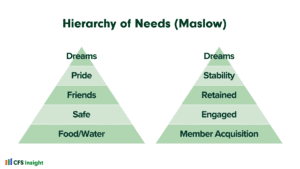Credit unions are known for their ability to provide personalized financial services to their members. With their focus on member satisfaction and community-driven approach, credit unions have established themselves as trusted sources of financial products and services.
However, in today’s competitive landscape, credit unions must rely on data mining techniques to better understand their members’ needs and preferences. By analyzing transactional data, credit unions can gain valuable insights into member’s buying behavior, financial needs, and product preferences and identify their competitors in real-time. In this article, we will explore how credit unions can use their own data and transaction marketing to provide better services to their members and stay ahead of the market.
1. Understanding that a Member’s Buying Behavior
Transactional data contains a wealth of information that credit unions can use to understand their member’s buying behavior better. By analyzing members’ transactional data, credit unions can gain insights into the products and services that are most popular among their members, as well as their buying patterns and seasonality. This information can be used to develop targeted marketing strategies and promotions tailored to the needs and preferences of specific members.
For example, a credit union may notice that many of its members are making purchases related to home renovations during the summer months. By using data mining techniques to analyze this transactional data, the credit union can develop targeted promotions and offers for home improvement loans or lines of credit during the summer months, when demand for these services is high. This can help the credit union increase its product adoption rates and revenue while providing its members with the products and services they need.
2. Identifying Member’s Financial Needs
In addition to understanding members’ buying behavior, credit unions can use data mining techniques to identify their members’ financial needs. Credit unions can gain insights into their member’s financial goals, debt management, retirement planning, and other financial needs by analyzing transactional data. This information can provide members with personalized financial advice and recommendations, helping them achieve their financial goals and improve their financial well-being.
For example, a credit union may notice that many members carry high levels of credit card debt. Using data mining techniques to analyze this transactional data, the credit union can identify these members and provide them with personalized recommendations for debt consolidation loans, financial education, or credit counseling services. This can help the credit union improve its member’s financial health while building long-term relationships with its members.
3. Better Product Recommendations (Next Best Product)
Credit unions can also use data mining techniques to provide better product recommendations to their members. By analyzing transactional data, credit unions can gain insights into the products and services that are most popular among their members and their buying patterns and preferences. This information can be used to provide personalized product recommendations to members, helping them find the products and services that best meet their needs.
Better targeting of products can lead to a significant increase in the success of marketing campaigns. By only targeting members where a product is relevant, you will see a substantial increase in the success of those marketing campaigns. Clients using these techniques will typically see a doubling of the ROI and a tripling their penetration rates.
4. Uncovering the Credit Union’s Competitors in Real-Time
In addition to providing better services to its members, credit unions can use data mining techniques to stay ahead of their competitors in real-time. By analyzing transactional data, credit unions can gain insights into the products and services that their members are using outside of the credit union and the financial institutions they are using. This information can be used to develop targeted promotions and offers tailored to the needs and preferences of specific members, helping the credit union increase its market share and stay ahead of its competitors.
Many CUs cannot quantify their competitors without making a significant one-off effort. For instance, many CUs can not say with any confidence how much they lose to their credit card competitors in total, let alone list how much for each one. Many of our clients are surprised by how much their members are sending to other credit card companies, even when they have competitive offerings. This data allows the CU to target specific competitors and tailor the message. You can also track this data over time to see if your position is getting better or worse with them.
5. Other Benefits of Understanding Member’s Buying Transactional Data
Beyond understanding a credit union member’s buying behavior, identifying a member’s financial needs, providing better product recommendations, and uncovering competitors in real-time, credit unions can benefit in other ways from analyzing transactional data.
For example, credit unions can use data mining techniques to:
- Identify high-risk members struggling financially and provide them with targeted financial advice and counseling services.
- Predict future trends and anticipate the needs of their members by identifying patterns and behaviors in their transactional data. This can help credit unions stay ahead of the curve and offer new products and services in high demand.
- Optimize their marketing and advertising campaigns by understanding the preferences and behaviors of their members. Credit unions can use data mining techniques to analyze member transactional data and develop targeted marketing campaigns that resonate with specific groups of members.
Conclusion
Credit unions can benefit significantly from analyzing their member’s transactional data using data mining techniques. By understanding their member’s buying behavior, identifying their financial needs, providing next best product recommendations, uncovering competitors in real-time, and utilizing the transaction marketing data for other purposes, credit unions can offer better services to their members, increase their market share, retain their members, and stay ahead of their competitors. Data mining can also help credit unions identify high-risk members needing financial advice and counseling services, predict future trends, and optimize their marketing and advertising campaigns.
With the right data mining tools and techniques, credit unions can turn their transactional data into valuable insights and use those insights to drive growth and improve their member’s financial well-being. CFS Insight makes this easy via our CFS Analytics Data Connector, which cleans, classifies, and structures a credit union’s transactional data into powerful datasets for easy reporting with actionable Power BI Dashboards; that can be utilized by everyone in the credit union.




